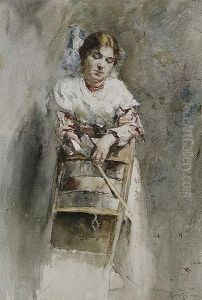Isidoro Garnelo Fillol Paintings
Isidoro Garnelo Fillol was a Spanish painter born on July 23, 1866, in Enguera, Valencia, Spain. He was a prominent figure in the Spanish artistic scene at the turn of the 20th century, particularly known for his paintings that reflected the academic and realistic styles of that period. Garnelo showed an early interest in art and was recognized for his talent from a young age. He moved to Madrid to study at the Real Academia de Bellas Artes de San Fernando, where he honed his skills and began to establish his reputation as an artist.
In 1887, Garnelo won a prestigious scholarship that allowed him to study in Rome, further enriching his artistic education. During his time in Italy, he absorbed the influences of the Italian masters and the classical heritage that would become evident in his later works. Upon returning to Spain, Garnelo continued to develop his career, participating in national exhibitions and receiving accolades for his work, which often depicted historical and mythological subjects, as well as landscapes and portraits.
Garnelo's painting style was characterized by a fine attention to detail, a masterful use of light and shadow, and a dedication to realism. This approach earned him a number of awards and recognition from various art institutions. Throughout his life, Garnelo also engaged in teaching, passing on his knowledge and technique to a new generation of artists.
The latter part of Garnelo's career was marked by a gradual shift in the art world, with new movements such as Impressionism, Cubism, and Surrealism gaining prominence. Despite these changes, Garnelo remained committed to his classical roots, although he did not achieve the same level of fame as some of his contemporaries who embraced the avant-garde.
Isidoro Garnelo Fillol died on October 13, 1944, in Montilla, Córdoba, where he had spent much of his life. His legacy is preserved in his numerous works, which can be found in Spanish museums and private collections. Garnelo's dedication to academic art and his role in the cultural life of Spain during his time have ensured that he remains a respected figure in the history of Spanish art.


